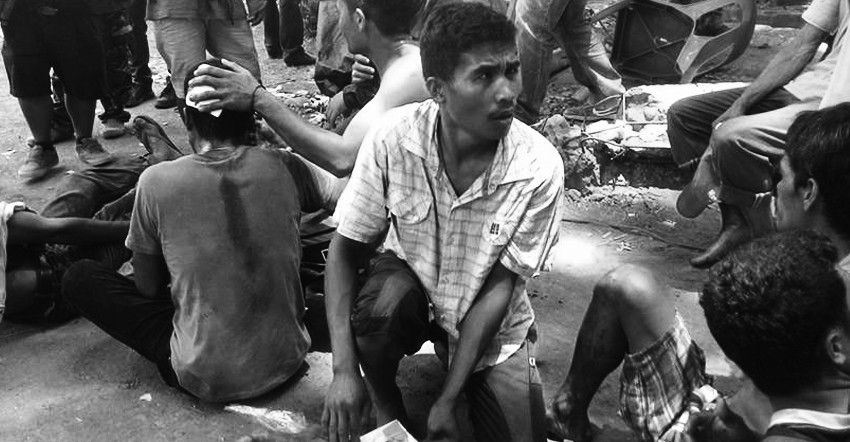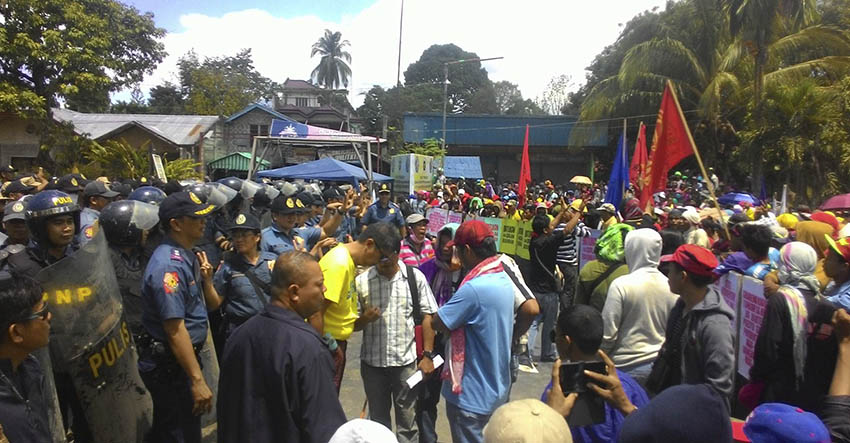
Photo by Kath M. Cortez
By Kath M. Cortez
On this day, six years ago, thousands of hungry farmers in the province of North Cotabato barricaded the main road of Kidapawan City to demand the immediate release of the provincial government’s calamity fund.
The barricade of six thousand-strong farmers lasted three days, but ended with bloodshed. Two were killed including a bystander, and hundreds were hurt during the brutal dispersal.
I was then the news director of a local radio station in Kidapawan when we received initial information from a leader of a farmer’s group about their plan to stage a protest in the city as many of their members reported massive effects of El Niño on their crops in the past months that caused widespread hunger among communities.
The initial information said thousands of farmers will camp out in front of the provincial capitol so that they can directly ask then-Governor Emmylou Taliño-Mendoza to act on their concerns.
Prior to the first day of the barricade, scores of farmers and their families arrived and sought refuge inside the United Methodist Church compound as organizers said they are still waiting for other farmers coming from the farthest areas of the province who are joining the protest.
“The United Methodist Church is the safest area in the city to accommodate us and can ensure our safety,” I remember Lito Roxas, one of the leaders, said in my interview with him inside the church compound.
Back in our newsroom, our mother station in Davao City decided to postpone our regular broadcast programs and focus on the protest the whole day. I can still remember having exchanges of conversation with the head of the News and Information Center (NIC), telling her no one wanted to talk and the protest has not yet started so we can only give snippets of what is happening on the ground.
Still, we chose to report, with so much patience and nerves to give updates on the day of arrival without even knowing that that was the beginning of all our April sleepless nights.
It was March 30 at around 7 am when thousands of individuals went to the main road of Kidapawan shouting their calls and immediately occupied the highway just in front of the church compound. Hearing their chants gave us a bit of goosebumps because we are not used to experiencing such a huge protesting crowd. The last one was when Typhoon Pablo survivors barricaded the highway of Compostela in 2013 demanding for relief goods.
Protesters installed their barricade that included their poor sound system to start their program. In the early hours, only a few members of the media were on the ground to report what was happening.
It was hours later when police arrived and started forming their dispersal team that included around three fire trucks from the Bureau of Fire and some police cars. Then the first of many failed negotiations and dispersals happened as protesters were firm with their call for immediate calamity assistance for the affected farmers including their demand for a dialogue with the governor.

Kidapawan City Mayor Joseph Evangelista negotiates with the protesters. (Photo by Kath M. Cortez)
The weather was so hot since the start of the barricade that even the dispersal team needed to put up tents for their personnel. They sometimes pumped water on the highway as the ground was so hot that even the asphalt road started to melt.
When the protesters said they will only leave the barricade and go home once the provincial government answer their demands, our main office also decided to do a 24-hour live coverage of the huge protest giving us no choice but to install a piece of ‘trapal’ or tent as our rally point and resting place in a parking lot of a new hotel just in front of the barricaded area.
In our place, we can see both the tired protesters and police from a full day of face-to-face pushing and negotiating under the scorching heat of the sun. We can also clearly hear the loud speakers from the side of the dispersal team throwing foul words against some activist leaders on the other side.
In the morning, we can smell fried bulad and burnt rice from the side of the protesters. Sometimes they even call us out, “basin gigutom sab mo ma’am mangaon sa ta (You must be hungry, come join us).”
Within the barricade, our reports focused on the difficulties experienced by the local farmers like losing their capital for their crops and even thinking of suicide to escape the hunger.
“Mas gusto na lang ko mamatay kaysa makita nga akong mga anak kausa na lang mukaon sa isa ka adlaw, kape pa gid ang sud-an (I would rather die than to see my child only eat one meal in a daw, and just have coffee grounds for a meal),” I remember a farmer from Mlang, Cotabato said that in my interview with while holding a placard.
Our live reports became their alarm clock in the morning as they listened to the interviews of leaders, farmers, and government officials about their plight. We were also aware that almost the entire city was listening to us to keep updated on what was happening inside the barricade.
But one funny thing about our coverage is that farmers started to avoid our interviews because they can hear their voices from their sound system. They were so shy that we even jokingly chased them around while they ran away from us for a live interview.
But that morning of April 1, around 10 am, was the last failed negotiation between the protesters and the local government. Mayor Joseph Evangelista and the chief of police of Kidapawan were in the picket line giving protesters only five minutes to leave the area but the farmers did not agree.
Then the violent dispersal happened less than the five minutes time set by the mayor. It started with the police using truncheons and shields to push back the protesters. Then they used the fire trucks to overpower the force of the farmers who fought back by throwing stones at them.
Minutes later, several farmers took control of the water cannons and pointed it at the dispersal team. I remember reporting it as ‘initial victory’ thinking that the attempt again failed to disperse the farmer’s barricade.
Then we heard a single gunshot. Then it became two, three and I lost count.
I can see people running in different directions but mostly rushing to the UMC gate shouting, crying, and raising their hands while the SWAT team chased them with open fire.
The bullets were bouncing off the ground while I was reporting live so I decided to take one step back to cover myself from a big pot of plant, then I noticed the person beside me looked at me while holding his belly. He wore white shorts and white sando, and he looked at me as if begging for help but I couldn’t hear him as I was too focused on reporting the situation while hiding.
Our eyes met for several seconds before he collapsed to the ground catching his breath so I called the person near me so we could make him sit in the shady area and ask for help. Some SWAT members and the police responded so I decided to go on with my live report.
On my last glimpse of him I saw his eyes open but not sure he is still alive. I later learned that he was just a bystander who became curious about the protest.
Our newsroom decided to give us a couple of minutes after the gunshots and dispersal to gather at our rally point in the basement of the hotel and we just started crying non-stop. We were all shocked to witness the incident but couldn’t stop because it is our job to deliver the news.
After we calmed ourselves for around five minutes we continued the coverage.
Still on the phone trying to give details on the dispersal, I entered the UMC compound along with two other local journalists where we witnessed wounded farmers left and right. Just looking at them I cannot continue to report so I turned off my phone and asked fellow reporter Sir Willamor Magbanua if we can assist those wounded for medical help.
We carried farmers with gunshot wounds who were bathed with their own blood to medical teams waiting outside the compound as many of them are afraid to go out because plenty of their colleagues were arrested outside.
In total around 120 farmers were injured while 81 others including senior citizens were arrested.
The following days of our live coverage after the violent dispersal were shifted to finding the missing farmers later found out to be arrested by police and were taken to different areas of the city.
Up to this writing no one is held accountable of the gruesome dispersal known as the Kidapawan Massacre. No one was held accountable after the incident. The commanding officer of the SWAT team Senior Superintendent Alexander Tagum got his promotion and became the City Police Director of Davao City while both Governor Emmylou Mendoza and City Mayor Joseph Evangelista ran and won the elections.
Meanwhile, arrested farmers faced lawsuits, but most have been acquitted. But justice remains elusive for the two murdered individuals. (davaotoday.com)










